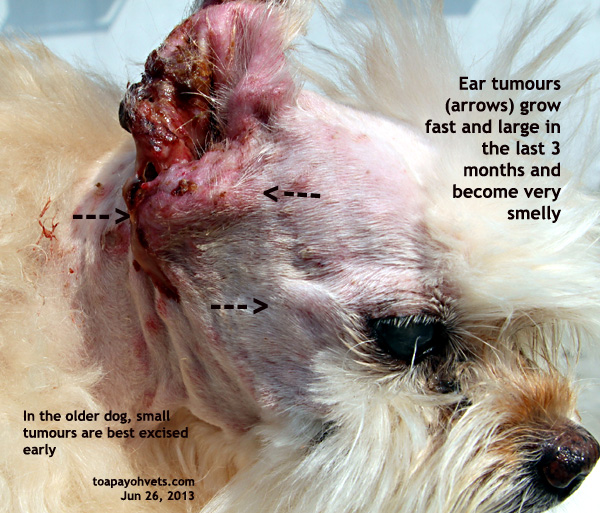1. Ear very "smelly". Has lots of pus and bleeding. She used cotton balls and antiseptic to wipe this large wound. I advised: "Use warm water & antiseptic and put into a scoop or syringe and irrigate area. Too large a wound to be cleaned by cotton balls.
2. Left eye can't close when the dog sleeps. "Most likely the tumour had involved the facial nerve which was damaged during the two massive ear tumour surgery," I said. "Use eye drops 3X/day and keep eye wet."
3. "Is the dog eating?" I asked on this 3rd day after surgery
"Yes, she eats by herself today."
4. "Is the dog in pain?"
"No," she said. "Only shakes her head."
5. History
A year ago, large "stomach lump" with nipple cut off was located near the "uterus". I told her this would be the mammary tumour. The petite fair lady vet whom I know to be a recent graduate at that time did advise histopathology of the lump but was rejected.
She had advised excision of the ear tumour which was small then, just like an extra piece of meat. Then 2-3 months ago, this ear tumour in the vertical ear canal grew fast and large. It became smelly. So, the dog needed a 3rd operation done by me to remove the ear tumours. The first op was spaying and the second one was the mammary tumour which does occur even in spayed dogs, but very rarely as compared to a female dog not spayed.
6. The pre-op blood test was requested by the lady on Jun 20, 2013.
LIVER. SGPT/ALT 94 (<59>
KIDNEY Urea 13.9 (4.2-6.3), creatinine 144 (89-177)
HAEMATOLOGY- normal but the lady had asked Dr Daniel for antibiotics. In conclusion, this dog was fit for anaesthesia. But she had heart murmurs and no ECG was done to lower medical costs.
7. Surgery done by me on Jun 23, 2013. My first consultation for the rotten ear was on May 30, 2013 and I had said the only option was surgery as medication would not last long to stop the ear scratching and bad smell. However, the dog was too old to take the anaesthesia and so the lady had to decide on the risks.
 The
right ear oozed out pus
over many months and
ulcerated due to
continuous scratching. It
was hardened rock-hard as
it evolved into ear canal
tumours. Hence a bony hard
vertical canal and a large
subcutaneous tumour
outside the vertical canal
were palpated. This means
there were actually two
ear tumours and this could
be malignant cancers as
they grow rapidly and
increase in size over 2-3
months.
The
right ear oozed out pus
over many months and
ulcerated due to
continuous scratching. It
was hardened rock-hard as
it evolved into ear canal
tumours. Hence a bony hard
vertical canal and a large
subcutaneous tumour
outside the vertical canal
were palpated. This means
there were actually two
ear tumours and this could
be malignant cancers as
they grow rapidly and
increase in size over 2-3
months. This was a messy surgery taking 51 minutes of isoflurane + gas and involvement of the facial nerves which if cut off, would affect the eyelid closing. Surprisingly, the old dog survived such a long surgery.
Not every aged dog survive such long anaesthesias and so it is best to get tumours excised when they are small and that includes breast tumours.
Conclusion.
Small tumours in old dogs
are best removed when they
are small.
In 10 days' time, I will
take out the stitches.
This dog was a puppy when
the lady was in Sec 2, she
told me. So, 14 years had
passed by so fast but the
dog looked so young owing
to excellent care.
This case shows that the
many of the younger
Singaporeans in their late
20s are much more educated
and sophisticated and will
care sufficiently to
ensure that their beloved
companion get back to good
health. This is unlike the
older baby-boomer
generation who would think
that it is cheaper to buy
a new puppy and let the
sick old dog die.
TIPS
I don't know how the
above-mentioned dog
develops ear tumours as I
had not seen this dog in
the past years.
Ear inflammation in your
dog, if left untreated for
many years, may evolve
into hard bony ear canal
tumours in old age. There
is the lateral ear
resection surgery to
resolve chronic ear
infections in floppy-eared
dogs, preventing later
medical problems. Many dog
owners are unaware of this
surgery and many vets
don't offer this surgery
as many owners seldom want
it, owing to the expenses
involved. So, the chronic
infection persists till
the ear canal hardens and
the tumours form and
become ulcerated and
infected.
 TOA
PAYOH VETS
TOA
PAYOH VETS






